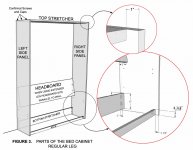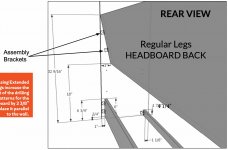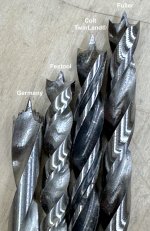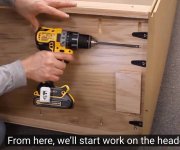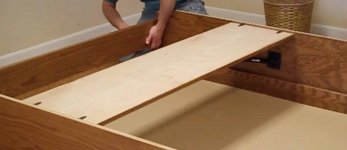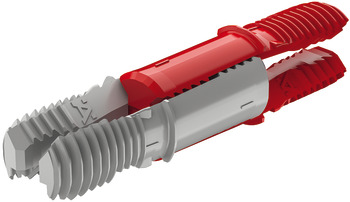smorgasbord
Member
- Joined
- Jan 7, 2022
- Messages
- 1,218
My seemingly never-ending Murphy Bed project is entering it's final stages.
A Murphy bed is a big thing, you assemble it in the room. And when you move, you disassemble and reassemble. I expect to maybe move once more in my lifetime, so not a biggie, but I want this to be strong and for someone after me to figure out what to do.
The Murphy Bed hardware kit comes with angle brackets and screws for attaching the top, front kick, back stretchers and headboard to the sides. That doesn't strike me as ideal. I had started down the path of unglued 6mm dominos and pocket screws, but am now rethinking the pocket screw aspect. Maybe I should be using Domino Connectors?
One maybe issue is that I only have a DF700. I do have the Seneca adapter so I can do 6mm and 8mm dominos just fine, which I think means I could use the DF500 connectors.
Question 1: Will I have a problem using with my DF700?
Question 2: Could I buy just the angle connectors (Festool 203166), the drilling guide (Festool 203164), and a 15mm drill bit? I really don't want to spend $435 for the whole kit, as I'd probably only use the angle connectors and don't have a Festool drill.
Question 3: Is this the right path, or should I just cheap out and get some the IKEA style connectors and use the drilling guide I already have? If so, any pointers to a good quality kit of connectors? Or, should I just stick with my domino and pocket screws plan - or something else?
The Murphy bed design is such that neither pocket screws nor connectors will be visible in the finished product from normal viewing angles (most on the back, and the top I'd do from the outside top instead of the inside as is normally done with connectors).
A Murphy bed is a big thing, you assemble it in the room. And when you move, you disassemble and reassemble. I expect to maybe move once more in my lifetime, so not a biggie, but I want this to be strong and for someone after me to figure out what to do.
The Murphy Bed hardware kit comes with angle brackets and screws for attaching the top, front kick, back stretchers and headboard to the sides. That doesn't strike me as ideal. I had started down the path of unglued 6mm dominos and pocket screws, but am now rethinking the pocket screw aspect. Maybe I should be using Domino Connectors?
One maybe issue is that I only have a DF700. I do have the Seneca adapter so I can do 6mm and 8mm dominos just fine, which I think means I could use the DF500 connectors.
Question 1: Will I have a problem using with my DF700?
Question 2: Could I buy just the angle connectors (Festool 203166), the drilling guide (Festool 203164), and a 15mm drill bit? I really don't want to spend $435 for the whole kit, as I'd probably only use the angle connectors and don't have a Festool drill.
Question 3: Is this the right path, or should I just cheap out and get some the IKEA style connectors and use the drilling guide I already have? If so, any pointers to a good quality kit of connectors? Or, should I just stick with my domino and pocket screws plan - or something else?
The Murphy bed design is such that neither pocket screws nor connectors will be visible in the finished product from normal viewing angles (most on the back, and the top I'd do from the outside top instead of the inside as is normally done with connectors).

